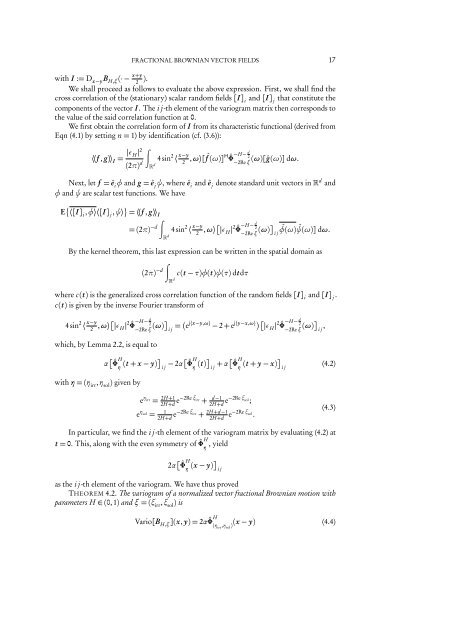FRACTIONAL BROWNIAN VECTOR FIELDS 1. Introduction. A one ...
FRACTIONAL BROWNIAN VECTOR FIELDS 1. Introduction. A one ...
FRACTIONAL BROWNIAN VECTOR FIELDS 1. Introduction. A one ...
Create successful ePaper yourself
Turn your PDF publications into a flip-book with our unique Google optimized e-Paper software.
<strong>FRACTIONAL</strong> <strong>BROWNIAN</strong> <strong>VECTOR</strong> <strong>FIELDS</strong> 17<br />
with I := D x−y B H,ξ (· − x+y<br />
2 ).<br />
We shall proceed as follows to evaluate the above expression. First, we shall find the<br />
cross correlation of the (stationary) scalar random fields [I ] i and [I ] j that constitute the<br />
comp<strong>one</strong>nts of the vector I . The i j -th element of the variogram matrix then corresponds to<br />
the value of the said correlation function at 0.<br />
We first obtain the correlation form of I from its characteristic functional (derived from<br />
Eqn (4.1) by setting n = 1) by identification (cf. (3.6)):<br />
〈〈f , g〉〉 I = |ε ∫<br />
H |2<br />
4sin 2 〈 x−y<br />
(2π) d 2 ,ω〉[ ˆf (ω)] H ˆΦ−H− d 2<br />
(ω)[ĝ(ω)] dω.<br />
d −2Re ξ<br />
Next, let f = ê i φ and g = ê j ψ, where ê i and ê j denote standard unit vectors in d and<br />
φ and ψ are scalar test functions. We have<br />
E 〈[I ] i ,φ〉〈[I ] j ,ψ〉 = 〈〈f , g〉〉 I<br />
= (2π) −d ∫<br />
d 4sin 2 〈 x−y<br />
2 ,ω〉 |ε H | 2 ˆΦ−H− d 2<br />
−2Re ξ (ω) i j<br />
ˆφ(ω) ˆψ(ω)] dω.<br />
By the kernel theorem, this last expression can be written in the spatial domain as<br />
(2π) −d ∫ d c(t − τ)φ(t)ψ(τ) dtdτ<br />
where c(t) is the generalized cross correlation function of the random fields [I ] i and [I ] j .<br />
c(t) is given by the inverse Fourier transform of<br />
4sin 2 〈 x−y<br />
2 ,ω〉 |ε H | 2 ˆΦ−H− d 2<br />
−2Re ξ (ω) i j<br />
= e j〈x−y,ω〉 − 2 + e j〈y−x,ω〉 |ε H | 2 ˆΦ−H− d 2<br />
−2Re ξ (ω) i j ,<br />
which, by Lemma 2.2, is equal to<br />
with η = (η irr ,η sol ) given by<br />
α ˆΦH η (t + x − y) i j − 2αˆΦH η (t) i j + αˆΦH η (t + y − x) i j<br />
(4.2)<br />
e η irr =<br />
2H+1<br />
2H+d e−2Re ξ irr +<br />
d−1<br />
2H+d e−2Re ξ sol ;<br />
(4.3)<br />
e η sol<br />
= 1<br />
2H+d e−2Re ξ irr +<br />
2H+d−1<br />
2H+d e−2Re ξ sol .<br />
In particular, we find the i j -th element of the variogram matrix by evaluating (4.2) at<br />
t = 0. This, along with the even symmetry of ˆΦ H η , yield<br />
2α ˆΦH η (x − y) i j<br />
as the i j -th element of the variogram. We have thus proved<br />
THEOREM 4.2. The variogram of a normalized vector fractional Brownian motion with<br />
parameters H ∈ (0,1) and ξ = (ξ irr ,ξ sol ) is<br />
Vario[B H,ξ ](x, y) = 2αˆΦ H (x − y) (4.4)<br />
(η irr ,η sol )
















